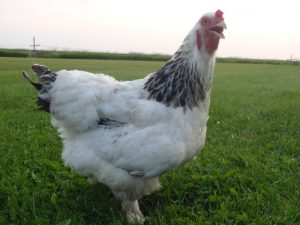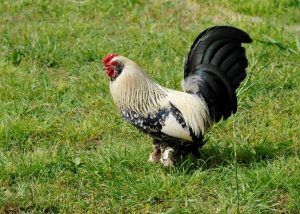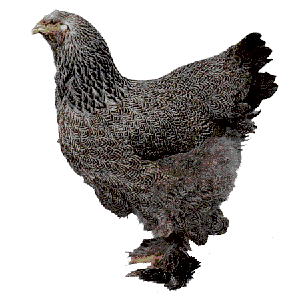
Overview
The Brahma chicken is named after the Brahmaputra river in India, despite having been developed in the United States. An Asiatic breed of fowl, also known as Chittagongs, Gray Shanghais, and Brahma Pootras, later shortened to Brahma, thought to have been a cross of the Malay and Cochin in India.
Imported from Shanghai, China, in the early 1840’s, they landed in New England much later. They were first imported into New York in 1846 and stock first reached England in 1853, where they caused a great stir. Brahma Chickens were included in the first book of poultry standards issued in 1865.
The name was shortened to Brahma in 1852 when a small flock was given to Queen Victoria. Fully grown, males can weigh up to 12lbs (5.5kg) and females can weigh 10lbs (4.5kg). The Brahma is a rather large and heavy bird.
Eggs
Size
Large size eggs
Color
Light to Dark Brown eggs
Production per year
150 eggs per annum
When do they start laying eggs?
From 6 months
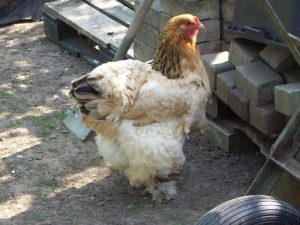
Brahma Characteristics
Temperament / Are they good as pets?
These chickens are calm birds and are usually non-aggressive so make for great pets.
How do I tame “Bearded d’Uccle” chickens?
The best way to tame a chicken is to handle it when it is still young, this gets your chickens used to people. If you have older chickens that need taming, try feeding them out of your hand.
How many do I need to buy?
2 chickens is the absolute minimum you need for a flock, we recommend around 6 as a small flock number.
How much space do they need?
They can tolerate confinement fairly well so you need around 25 square feet per chicken in their run.
Will they mix with my other chickens?
Yes, they’re non-aggressive and should mix well with your other chickens.
Appearance
There are three recognized varieties of the Brahama: light, dark and buff.
The light Brahma has white plumage, the saddle feathers are mixed with black and they have black tail feathers.
The buff Brahma has a similar appearance but has a golden plumage instead of a white one.
The dark Brahma is either a dark amber with the hen having grey and black saddle feathers and the cock having white and black ones.
The head and skull are important breed characteristics. Texture of the feathers is also of great importance, for the plumage, should be smooth fitting and not loose-feathered and soft as in the Cochin.
A huge, very good natured and docile bird that can make super pets. A general purpose fowl for heavy meat production.
Feeding
What should I feed them?
When you first get your chickens you should feed them growers mash as it has a higher percentage of protein (19{cfcd481556a8b43fba6af451761032bd323e94372a0c1e607}) and is refined so that it can be easily ingested. You should feed them growers mash up until 6 weeks where they should be fed chicken pellets which is just feed in pellet form, this has between 15-16{cfcd481556a8b43fba6af451761032bd323e94372a0c1e607} protein. At 18 weeks your chickens need more nutrients to help with egg production so slowly start feeding them layers mash or pellets which has around 16{cfcd481556a8b43fba6af451761032bd323e94372a0c1e607} protein.
How much should I feed them?
Chickens eat anywhere between 2.9 oz (80g) and 4.2oz (120g) a day, but on average breeders feed their chickens ¼ of a pound (113g). Start by feeding them this and then adjust the weight of feed around how much they consume. You can leave the feed in a feeder for them to eat whenever they please or you can give them set meal times.
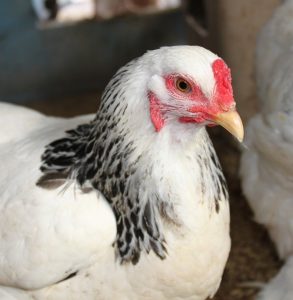
What can’t they eat?
Chocolate and beans are the two main foods that shouldn’t be eaten by chickens. The phytohemagglutinin in beans can lead to fatalities and the theobromine in chocolate can cause heart problems. Moldy food that has bad bacteria in it should not be fed to chickens as it can make them very unwell. For this reason, it is illegal to feed your chickens leftovers in the UK.
What do I need to keep chickens?
The most essential item you need to keep chickens is a coop, which should be 1.1m2 or 11 square feet per chicken. Their run needs 25 square feet per chicken. In the coop they should have a perch to sleep on and a wooden laying box for their eggs.
You should invest in a sunken fence to go over and around the coop to keep them safe at night. Find a water bowl which they can’t stand in or push over and place it in the shade so the water doesn’t get too warm.
Your chickens need grit to help with egg production so make sure there is always some that they have access to.
Breed Tips
- The Brahma Chickens are not great egg layers although they brood. Having said that they lay are known for their good winter production of brown eggs.
- Very children friendly.
- Brahmas do all right in confinement if given the correct amount of space but will excel further when given access to the outdoors.
- A breeders favourite, as even today breeders are developing new color varieties including blue, partridge and red.

